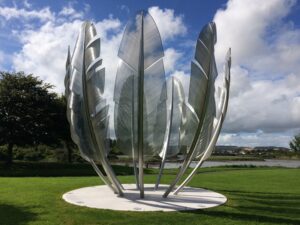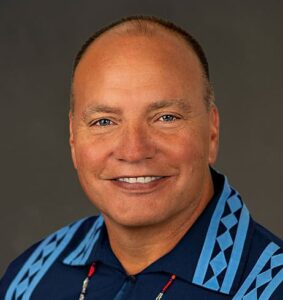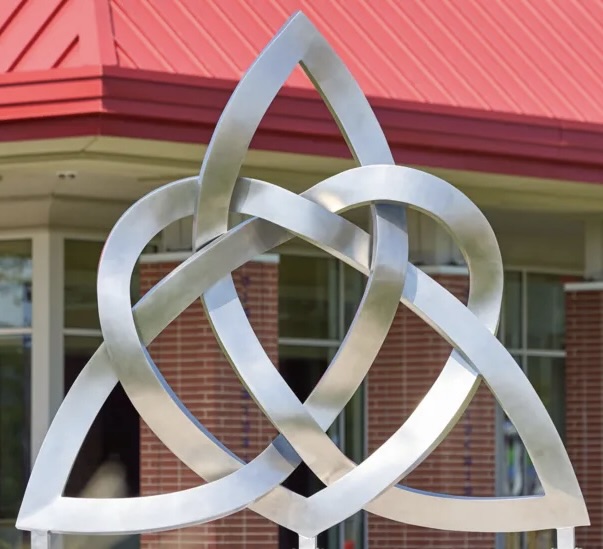I'm loving the latest turn in the story of the enduring connection between the Choctaw Nation and the people of Ireland– a striking new 8-foot-tall sculpture in Oklahoma, by tribal member Samuel Stitt.
It combines a Celtic trinity shape intertwined with a heart and is placed facing toward Ireland, honoring a gesture of generosity a century and a half old.
Choctaw Nation: Trail of Tears
During the Great Famine of 1847, the Choctaw people were facing their own horrendous hardships. In 1831, they had been the first tribe to be forcibly removed from their homelands, under the U.S. “Indian” Removal Act of 1830, signed by President Andrew Jackson.
This marked the beginning of the “Trail of Tears”–the forced removal and relocation of Native American tribes from their ancestral lands into designated “Indian” territory, for the Choctaw, primarily present-day Oklahoma.

Kindred spirits monument in Cork, which inspired the twin Eternal Heart monument in Oklahoma
Throughout the 1830s, over 20,000 Choctaw people were uprooted and forced to leave their lands in Mississippi.
They had to make the perilous journey on foot, without sufficient food, supplies, or shelter, during harsh winter conditions. Many succumbed to disease, starvation, and exhaustion along the way.
It’s estimated that thousands died before reaching their destination in Oklahoma.
Despite these devastating losses, the Choctaw people managed to rebuild their community in the years following their relocation, to the degree that just 16 years later, they were able to extend aid to the Irish during the Great Famine.
Despite vast cultural and geographical differences, in a gesture of empathy that recognised a shared experience of colonialism, the Choctaw Nation donated $170 to an Irish relief fund, in 1847 is often cited as an example of ,
It remains one of the most touching and enduring examples of cross-cultural compassion in history, forging a bond that continues to be honored today through gestures like the Eternal Heart sculpture and the twin Kindred Spirits monument in Ireland.

Chief Gary Batton
It also serves as a reminder of the Choctaw’s resilience and their commitment to helping others
Gary Batton, 47th Chief of the Choctaw Nation of Oklahoma, described the sculpture as a symbol of an “eternal bond” between the Choctaw and Irish.
“We are extremely proud to call the people of Ireland our friends and kindred spirits.”
Choctaw-Irish Connection: A Timeline
1800: The Act of Union formally abolishing the Irish Parliament and uniting the Kingdom of Great Britain and the Kingdom of Ireland into a single political entity the United Kingdom of Great Britain and Ireland is passed.
1830: The Choctaw sign the Treaty of Dancing Rabbit Creek with the United States, ceding traditional lands in Mississippi in exchange for land in the west, in what was then “Indian” Territory (now Oklahoma).
1831-1833: The Choctaw people are forcibly removed to “Indian” territory. Thousands perish from starvation, exposure, and disease on the Trail of Tears.
1845: Crops begin failing in Ireland due to an infestation of Phytophthora infestans, the pathogen responsible for the potato blight.
1845-1852: The Irish Potato Famine devastates Ireland, with over one million people dying from starvation or famine-related diseases, and another million emigrating to countries such as the United States, Canada, and Australia.
1847: The Choctaw people, despite their own recent suffering, collect a donation of $170 (over $5,000 in today’s money) to aid the Irish during the famine.
1848: A report on aid to Ireland notes, “The largest part was contributed by the children of the forest, our red brethren of the Choctaw nation.”
1906: The Choctaw tribal government is dissolved by the U.S. federal government as part of efforts to assimilate Native Americans.
1907: Oklahoma becomes a state; the Choctaw people become citizens of this new state.
1921: Most of Ireland gains independence from the United Kingdom, following the Anglo-Irish Treaty that ends the War of Independence. Northern Ireland remains part of the U.K.
1976: The U.S. Congress passes a law allowing for the restoration of Native American self-government.
1983: The Choctaw Nation enacts a new constitution and reestablish their tribal government.
1990: Choctaw leaders visit County Mayo, Ireland, to participate in the first annual “Famine Walk,” a re-enactment of the desperate journey taken by Irish famine victims in 1848 to seek aid from their landlord.
1992: Irish representatives visit the Choctaw Nation and participate in a symbolic trek from Mississippi, retracing the original Trail of Tears.
1992: A plaque commemorating the Choctaws' aid during the Irish Famine is installed in the Mansion House, the official residence of the Lord Mayor of Dublin.
1995: Irish President Mary Robinson visits the Choctaw Nation tribal headquarters and expresses Ireland’s enduring gratitude for the Choctaw people’s generosity.
2017: The sculpture “Kindred Spirits” by Irish artist Alex Pentek is dedicated in Bailick Park, Midleton, County Cork, Ireland. The monument, featuring nine stainless steel eagle feathers arranged in a circle, commemorates the Choctaw aid during the famine and the enduring bond between the two peoples.
2018: Ireland’s Taoiseach (Prime Minister) Leo Varadkar visits the Choctaw Nation tribal headquarters and says, “A few years ago, on a visit to Ireland, a representative of the Choctaw Nation called your support for us ‘a sacred memory’. It is that and more. It is a sacred bond, which has joined our peoples together for all time.”
2019: The first recipient of the Choctaw Ireland Scholarship begins her studies in Ireland, a further mark of the connection between the two nations.
2020: In recognition of the kindness shown by the Choctaw people in 1847, the Irish people “pay it forward” by raising donations to support the Navajo and Hopi Nations during the coronavirus pandemic, continuing the legacy of cross-cultural generosity.
2023: The sculpture “The Eternal Heart”, created by Choctaw artist Samuel Stitt, is unveiled in Tuskahoma, Oklahoma.
